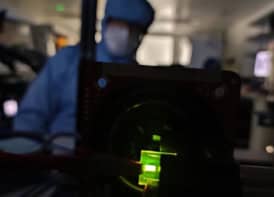Einstein’s special theory of relativity has passed its toughest test yet. Achim Peters of the University of Konstanz in Germany and colleagues used a super-stable laser standing wave to check the theory three times more accurately than previous similar experiments. Tests of special relativity are crucial: not only is the theory a cornerstone of modern physics, but tests could lead to a long-sought-after ‘theory of everything’ or the discovery of quantum gravity (C Braxmaier et al 2002 Phys. Rev. Lett. 88 010401).
Special relativity states – among other things – that the speed of light is the same no matter how fast an observer is travelling. The so-called Kennedy-Thorndike experiment tests this prediction by monitoring the oscillations of a light source as it accelerates and decelerates.
Using this technique, Achim’s team set up a standing wave of laser light in a cryogenic optical resonator – or ‘CORE’ – in which the frequency of the standing wave can remain stable over very long periods. For 190 days, they compared its oscillation frequency with that of a standard iodine ‘clock’, which is based on the radiation corresponding to the energy gap between two well-known electronic states in an iodine molecule. In this time, the Earth completes over half its circuit around the Sun and – accounting for the rotation of the Earth – the velocity of the Konstanz lab changes by about 30 kilometres per second.
The team found that frequency of the light in the CORE remained constant throughout the experiment, confirming that – over this velocity range – the speed of light is indeed independent of the velocity of the laboratory in which it is measured. This amounts to a verification of the special theory of relativity three times more accurate than previous tests based on the Kennedy-Thorndike method.
The 190-day measurement was made possible by the extreme stability of the CORE, which consists of a sapphire cavity chilled to 4 kelvin. At this temperature, there is virtually no thermal vibration in the crystalline structure of the cavity, which would cause the frequency of the standing wave to drift. This effect meant that earlier experiments could only run for a matter of days, during which time the velocity of the Earth changes less dramatically.
Achim and colleagues point out that the accuracy of their set-up was limited by the stability of the iodine clock. They believe that recently developed optical clocks – which are around seven times more accurate than the best atomic clocks – will allow them to test special relativity even more stringently in future.



